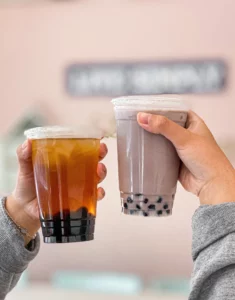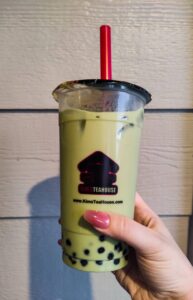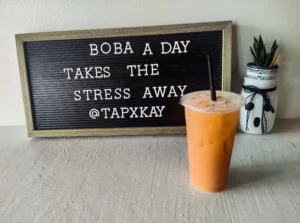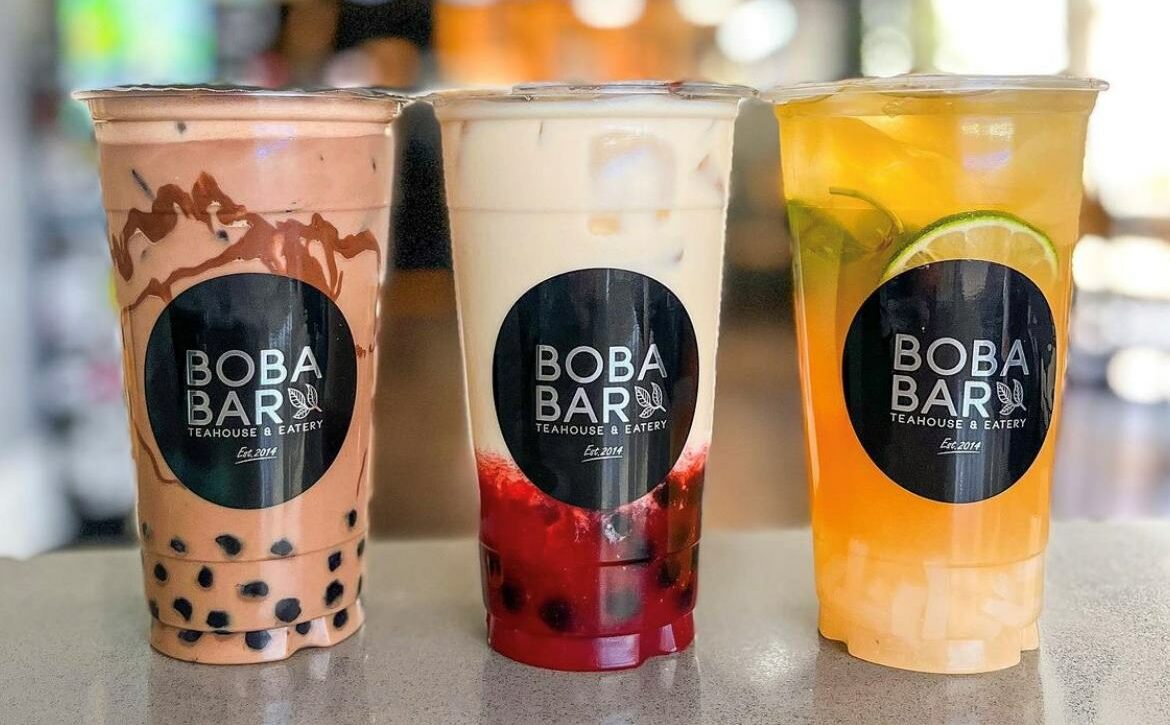How boba became a worldwide phenomenon
Boba tea, bubble tea, pearls, tapioca balls— it goes by many names, but its spike in popularity in the United States over the last decade cannot be denied.
A little over ten years ago, the boba landscape of Houston looked much different than it does today. They were out there, but normally you’d have to drive a bit to find one— nowadays, they’re almost as common as seeing a Starbucks in every shopping center. From well-known chains like Kung Fu Tea, Sharetea, and Gong Cha, to local boba chains such as Kim’s Teahouse, Tapioca Xpress, and Yan Tea Cafe, they are easy to find.
So what caused the sudden boom in boba businesses in Houston and all over the country, and why is it so popular with people in the United States and abroad?
What exactly is boba?

Boba is made from tapioca or cassava starch; bonus point is it is gluten-free! When making it the traditional way, the starch is kneaded and shaped into balls, then dropped into a pot of boiling brown sugar water. Lucky for us, there are many types of pre-made boba that you can buy at the store. These require minimal effort. Just drop the pearls into some boiling sugar water.
Although boba in its original state is pretty flavorless, more and more people have begun experimenting with flavored boba over the years. Making the boba flavored is quite easy; simply add the flavor or fruit to the tapioca starch before it is kneaded. Popular flavors include but are definitely not limited to, lychee, matcha, strawberry, ube, and mango.
So what exactly is boba tea? Boba tea, at its most basic, is a drink with tapioca or fruit-flavored pearls. However, it is much more complex than that. The drink itself ranges, but traditionally, it is a mix of freshly brewed tea and a liquid base (usually a dairy or non-dairy creamer) that is typically sweetened and flavored. These flavors can be fruits, syrups, or powders. Popular flavors include strawberry, taro, Thai tea, matcha, brown sugar, almond, and honeydew. The boba pearls are then added in to make the drink we know and love! If you want to spice it up, you could add jelly, pudding, popping boba, or top it off with salt or cheese foam.
Boba throughout history
The origin of boba tea is hotly debated. Some say it was first invented when, in 1988, product development manager Lin Hsiu Hui poured her iced tea over her sweetened tapioca pudding (called fen yuan, a traditional Taiwanese dessert) during a board meeting. The other employees at the meeting gave it a try and all loved it. Others say it was invented in 1986 by Taiwanese artist Tu Tsong-He who, in an attempt to get out of debt, created a new drink for his tea shop while playing around with fen yuan. Regardless of the origin story, the fact that boba tea was created in the 1980s in Taiwan, specifically in Tainan and Taichung, cannot be debated.
The tea drink was originally created as a light, portable dessert to drink while on the go. The teas were originally flavored with actual fruits, but when this became too laborious and expensive, many tea shops switched to using fruit-flavored syrups and powders. As for the creamer, non-dairy seemed to be the way to go given its rich, creamy texture. Original toppings for the tea included typical Taiwanese dessert toppings like boba, egg pudding, grass jelly, red bean, and almond jelly. While these toppings are still popular and can be found in most tea shops today, the menu has expanded significantly.
After its invention, boba tea became a hit at night markets all over Taiwan. According to Food and Wine, night markets in Taiwan are filled with food and drink vendors, and trends within these food stalls tend to come and go quickly. However, boba tea has remained a steadfast staple. It is not uncommon to see happy customers carrying their tea around while visiting other stands within the night market.
Boba entering the United States


Thanks to tourism and globalization, as well as social media and technological advancements, boba tea has grown in popularity, dating back to the 1990s. Although the 1990s brought political liberalization to Taiwan, encouraging many to move back, the United States saw large numbers of affluent Taiwanese Americans moving to upscale neighborhoods in California, according to Wikipedia. With this influx of immigrants came the introduction of bubble tea into Western culture. Not surprisingly, the first boba stores were found in Southern California, with popular Taiwanese chains like Quickly and Q-Cup. Not soon after this launch, they began expanding to other states during the late 1990s to the early 2000s.
The rise in cafe culture across the United States, thank you Starbucks, gave way for boba shops to assimilate in a similar fashion. Unlike in Taiwan, where boba was found at night markets and food carts, it was now styled in coffee-houses and cafe-style shops. Instead of being a portable treat, people were sitting and enjoying the drink much like they would a cup of coffee. During this period, bubble tea also made its debut in Houston, with stores like Tapioca House opening in 2000 and other smaller, family-owned stores popping up in the Houston Chinatown area.
By the mid-2010’s, it became clear boba was here to stay in the United States. In 2013, the Fung Brothers released “Bobalife“, which has garnered 2.4 million views and county. This song made its way to mainstream media in America and thus gave traction to an even bigger boom in the boba tea industry.
Why so popular?


Simply put, bubble tea is popular because it is delicious, fun, convenient, and intriguing. There is nothing comparable to the tea’s creamy texture, the refreshing flavors, and the fun additions that make bubble tea such a unique treat.
Because there is nothing like bubble tea on the market, it makes it a much sought-after drink. The way that it is made and the flavors offered can’t be found at your run-of-the-mill coffee shop. The textures of the boba, jellies, puddings, and other additions make it a delicious and fun drink, which is why so many people have discovered a love for the tea.
Some of its rise can also be accredited to the world of social media. The appearance of these drinks and the trendy shops themselves are considered highly “Instagramable.” Many stores have caught onto this trend and have adjusted accordingly. Creating hot new menu items that include vivid colors and interesting visuals adorned with things like Pocky, cotton candy, dry ice, and more. The aesthetic drinks encourage customers to visit so that they can snap the perfect photo for their feeds.
Additionally, bubble tea is a safe bet for those who are health-conscious or have food restrictions. You can fully customize each drink, down to the ice level. You decide what goes in the drink so that you do not have to worry about a diet being ruined or having an allergic reaction.
And the wide variety of flavors and additions make it so that even the pickiest of eaters can find a drink they will enjoy.
Lastly, this is a fairly cheap option for a nice and refreshing treat. The average consumer can enjoy boba tea without having to worry about breaking the bank.
What caused the boom in Houston?
The rise in popularity of boba stemmed from the same reasons it became popular globally, but also because of the unique food destination that Houston has become. Houston is known as a “foodie city,” and for good reason. The 640.4 square miles Southern city boasts around 10,000 individual restaurants that represent at least 70 different countries, making it easy to find unique, creative dishes from all over the world. As Rice University Kinder Institute claims, Houston is “one of the country’s most ethnically and culturally diverse metropolitan areas.”
This inclusive atmosphere in regard to food makes Houston a hot spot for those looking to open bubble tea stores. With people from so many cultures thriving in the city, it makes sense that they would be more open-minded to trying the dessert-esque drink. And with more people becoming obsessed with taking Instagrammable photos of their drinks and shops learning to create drinks that cater to those crowds, more drink shops are popping up.
The drink has become so popular that not only are there shops almost everywhere you look but they can even be found in grocery stores and on menus in restaurants as well. Bottled versions of the drink can be found in Asian markets and on the aisles of H.E.B., a popular grocery store chain that is only found in Texas. Rice University even has its own bubble tea supplier called East-West Tea, which is student-run.
Once you have tried boba tea, it becomes clear why it is so popular. And if you have never tried it, it is definitely worth a try!

